In early March I posted – Perth Metro BoM station 09225 looks to be reading too warm from mid-2011 – could much publicised summer hot days be exaggerated ? – and sent the following fax to the BoM Perth Office asking if they would check this out and let me know what they found. I also faxed BoM head office.
Bureau of Meteorology
Western Australia
PO Box 1370
West Perth WA 6872
(1100 Hay Street)
Fax: (08) 9263 2233
4th March 2013
Dear Officer in Charge,
I have noticed what appears to be a sudden warming jump in Perth Metro max temperature data starting July 2011.
See my blog post –
Perth Metro BoM station 09225 looks to be reading too warm from mid-2011 – could much publicised summer hot days be exaggerated ?
www.warwickhughes.com/blog/?p=2129
Do you know why Perth Metro max suddenly started reading warmer compared to Perth Airport from mid July 2011 ?
Can you check and let me know ?
Many thanks,
Yours sincerely,
I have just had the following reply telling me things I already knew – which fails to address the Perth Metro data issue I specifically raised.
Dear Warwick,
This message is to notify you that your enquiry to the Bureau of Meteorology has now been finalised and closed by our team. To access our suite of free data online or to make subsequent requests for data please explore our new Weather Station Directory at www.bom.gov.au/climate/data/stations/ . If you require additional information please lodge a new enquiry via our web form at www.bom.gov.au/climate/data-services/data-requests.shtml .
Feedback
We are constantly working to improve our service and appreciate your feedback. If you would like to contribute, please complete our 2 minute survey at www.bom.gov.au/climate/surveys/customer_feedback.shtml .
Regards,
Climate Data Services
Bureau of Meteorology
What does it all mean ?
My take is that I pinpointed a data fault that they do not want to address – and now they hope I will go away.
Translation: Temperatures have now been finalised and closed shut by our experts. Our service is perfect. You are not an expert, so go away now!
Another BoM reply has come in – with some explanations.
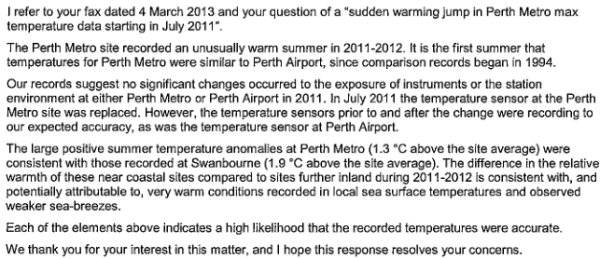
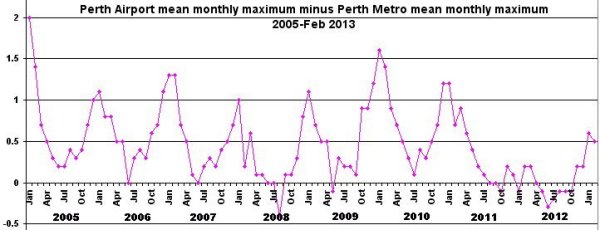
To that I would say it is not just a summer issue.
Look at my chart from comment 3 in my original post –
from July 2011 the differences are marked at most times of the year compared to the regular pattern of the previous six years.
Your query: Perth Metro BoM station 09225 looks to be reading too warm from mid-2011
Their reply: The temperature sensor at the Metro site was changed in July 2011
Their conclusion: No problem.
Warwick, don’t waste time on them, not until you hear that they’ve employed an intelligent ten year old.
Warwick
I guess you’ve already checked this out – and as it is contrary to your argument you haven’t posted it.
Airport – Swanbourne shows the same July / August / September dip as Airport – Mount Lawley in 2011 and 2012
Airport – Swanbourne shows the same October / November / December dip as Airport – Mount Lawley in 2011 and 2012
Looks like they were right and you were wrong. Can you say “oops I stuffed up – sorry” ?
.. and as the links didn’t publish ..
July / August / September
October / November / December
Thanks for sharing your Swanbourne comparisons.
I have not looked at Swanbourne yet – IMHO the degree of coastal influence maked it less suitable to arbitrate between Metro and Airport.
It would have been helpful if the BoM had included some of their analysis – they had a couple of weeks.
Busy today and hope to check Swanbourne Sunday.
Thanks again for your comparisons.
Had a look at all 3 lcations on Google Earth.
Swanbourne the best. In the dunes between the West Coast Highway and the ocean. Natural vegetation and just a couple of small buildings nearby. But will be sensitive to timing of sea breeze.
Mt Lawley has 2 large areas of irrigated grass, one about 20 meters away, the other 100 meters away. Roads and many buildings in the vicinity.
Airport is downwind of a building and a small area of irrigated grass.
As I have previously pointed out, there have been successive restrictions on irrigation here in Perth in recent years, and readings from any station in proximity to irrigation will be climatologically worthless IMO.
I’d add, warmer land temperatures should cause stronger and earlier sea breezes. So its interesting that Swanbourne is the warmest, and supports weaker sea breezes as the cause.
This exercise lead to discovering that there is a significant cooling drift in Perth Airport max anomalies post the October 1997 site move, relative to the other three stations. These anomaly differences clearly reflect the 1997 relocation at the Airport and illustrate a drift after that which has accelerated in the last five years or so.
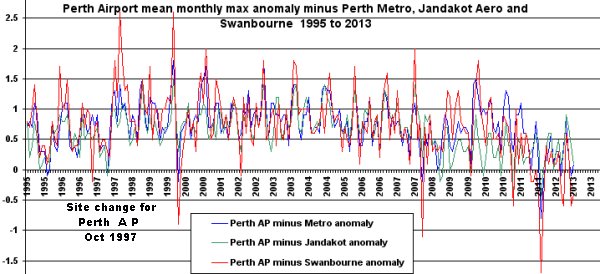
Trends for the period post Nov 1997 are –
Perth AP minus Perth Metro
Entire Period -0.57
Per decade -0.38
Perth AP minus Jandakot
Entire Period -0.59
Per decade -0.39
Perth AP minus Swanbourne
Entire Period -0.95
Per decade -0.62
One interesting point about the Perth Airport site is a large drain with running water a few metres from the instruments. If flows were increasing in the drain – could this explain the negative drift. Considering the hundreds of ha of bush around Perth Airport it seems unusual to site the weather instruments metres from a drain on the scale of a canal.
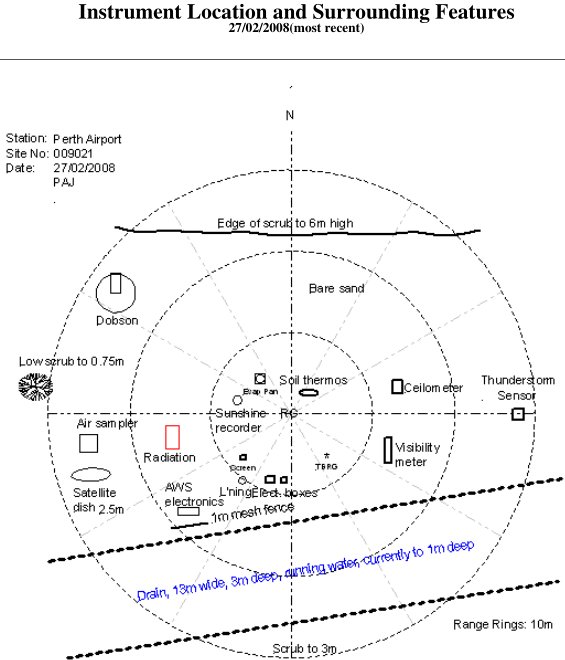
Perth Metro is an unsuitable site hard up against a busy university and near grassed sporting areas that might be irrigated at times.
The BoM is their statement in my comment 2 refer to the warmer summer of 2011-2012 being “potentially attributable” to warmer SST’s.
Warmer SST’s could cause some moderate days to be warmer near the coast but peak hot days at Swanbourne seem clearly associated with easterly wind. Data for last summer with wind direction are available here – select the month you want under the Table.
Here is another comparison of mean monthly maximum anomalies this time between Perth Metro and the three neighbours and I have included a nine month moving average help pick out trends.
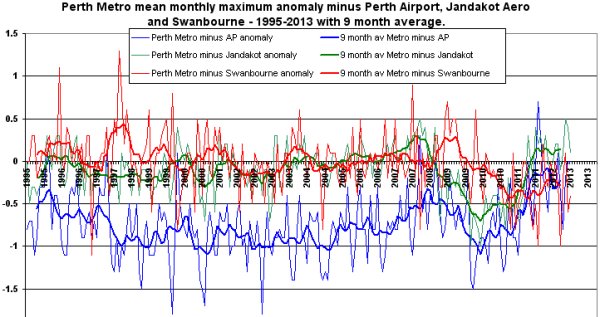
It looks likely that around the start of 2008 Perth Metro commenced a cooling relative to Jandakot and Perth Airport. Then in early 2010 this trend reversed and Metro warmed compared to Airport and Jandakot. This trend saw Metro returning close to the longer term trend with Jandakot but showing record warmth compared to Perth Airport. In my opinion these trends in Perth Metro post 2007 are non-climatic and due to poorly understood variations in the environment surrounding the instruments.
In my 25 Feb 2013 post – Satellites define the surface urban heat island (UHI) for 419 global cities – it is clear that satellite based measurements of surface heat 2003-2008 show Perth urban areas are 1 to 2°C warmer than rural surroundings during both night and day. This means that since weather records began in the 1800’s UHI effects have inflated Perth readings by 1 to 2°C. However is this ever acknowledged in BoM statements about “hottest this or that” temperature records ?
Sigh .. this is basic meteorology .. higher near coastal SSTs mean weaker afternoon sea breezes.
Swanbourne (on the coast) has warmed more than Jandakot and Perth Metro (11km from the ocean). They have warmed more than Perth Airport (21km from the ocean) and that has warmed more than Pearce (31km from the ocean). Yep – the trend has Perth Airport warming more than Pearce has (0.31 since 1998)
You’ve successfully proved that weaker sea breezes over the past 15 years have resulted in warmer near coastal temperatures.
Just to demonstrate it – the difference in January to March surface wind 1998 to 2012 minus 1977 to 1996 – note the residual easterly.
And in case you doubt the SST – the difference in January to March SST 1998 to 2012 minus 1977 to 1996 – note the extra 0.5c.
Unless of course NOAA are in on the conspiracy as well…
(your really gunna have to fix the linking code)
Just to demonstrate it – the difference in January to March surface wind 1998 to 2012 minus 1977 to 1996 – note the residual easterly. Link 1
And in case you doubt the SST – the difference in January to March SST 1998 to 2012 minus 1977 to 1996 – note the extra 0.5c. Link 2
Warwick
Any comment? Or do you only comment on items that support your hypothesis?